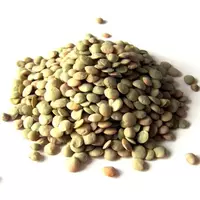Lentil

Lentils are mentioned in the books of the Old Testament, as one of the main foods of our ancestors. Lentils were grown in the Mediterranean and Central and Asia Minor. Now it is difficult to imagine, but before the revolution, Russia was the world leader in the volume of crops of this culture. It was grown for export and for its own needs. At the end of the 19th century, during a severe drought, only lentils were born to fame and actually saved our country from imminent famine.
Perhaps the main drawback of lentils can be called the fact that it ripens unevenly: even on one stem, half of the pods can already fully ripen, and half can remain green. In the era of global mechanization, growing lentils has become simply unprofitable, and here India has become the leader in terms of the volume of crops of this crop, where the population is large and the labor force is cheap.
Benefits of lentils
Lentils occupy the first place among legumes in terms of vegetable protein content, it is easily absorbed and perfectly nourishes the body. Lentils, according to vegetarians, can replace meat, because the protein in it is about 60%. But there is practically no fat here, which is also its undeniable advantage and demonstrates the benefits of lentils. Lentils are also leading in terms of folic acid content (100 grams of the product contains almost 90% of a person's daily need for this substance). Soluble fiber, which is part of lentils, has an extremely beneficial effect on the work of the gastrointestinal tract.
Minerals and trace elements in lentils are present in great variety, determining the beneficial properties of lentils. There is potassium, calcium, sulfur, phosphorus magnesium, iron, zinc, manganese, etc. Lentils contain unique substances - isoflavones, which have the ability to suppress breast cancer. These substances are preserved after various types of treatment, so it is possible and necessary to buy concealed lentils and dried ones, the benefits of lentils do not decrease. Some varieties of lentils, of which there are large quantities, are able to lower blood sugar levels and are useful for patients with diabetes mellitus. Mashed lentils are recommended to be included in the diet for colitis and stomach ulcers.
Lentils may have a not quite presentable appearance, but it is distinguished by a subtle and pleasant taste. Almost all the beneficial properties of lentils are preserved in boiled form. For a long time, the therapeutic effect of lentils has been known. It was recommended to be used in order to restore mental balance. Lentil porridge strengthens the immune system, restores metabolism, improves heart function and strengthens the walls of vessels and capillaries.
Harm to lentils
An important point that demonstrates the harm of lentils not so much for health as for a figure is lentils are far from a dietary product. Depending on the variety, its calorie content can vary from 280 to 310 kcal. per 100 gr. Lentils should be used with caution in people with a sick stomach. The process of digesting it, no matter what, is a serious test for this organ. The protein found in lentils, although useful, is not able to completely replace animal proteins. This should also be remembered if you decide to follow the vegetarian diet regime.
lentils 295 kCal
Energy value of lentils (Ratio of proteins, fats, carbohydrates - ju):
Proteins: 24 g (~ 96 kCal)
Fats: 1.5 g (~ 14 kCal)
Carbohydrates: 46.3 g (~ 185 kCal)
Energy ratio (bj | y): 33% | 5% | 63%
 Español
Español Français
Français Português
Português Русский
Русский 简体中文
简体中文 繁體中文
繁體中文 日本語
日本語 한국어
한국어 العربية
العربية Türkçe
Türkçe Қазақ
Қазақ Deutsch
Deutsch Italiano
Italiano Українська
Українська
